the railways in yeovil
yeovil town station
Yeovil's central railway station
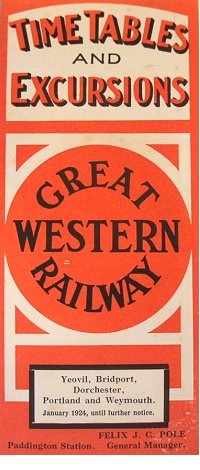 Yeovil Town
station, built
on a field of
Newton Farm
called
Barrowhayes
(Parcel 498), opened
in 1861 It was a
joint station
built by the
London and South
Western Railways
Company (L&SWR)
and the Great
Western Railway
Company (GWR)
and Hendford was
then used for
goods only. For
many years
Yeovil Town
station was well
known for having
two Station
Masters, one for
each of the
railway
companies
operating
through it -
Frederick
Maunder (L&SWR)
and George K
Forster (GWR).
Yeovil Town
station, built
on a field of
Newton Farm
called
Barrowhayes
(Parcel 498), opened
in 1861 It was a
joint station
built by the
London and South
Western Railways
Company (L&SWR)
and the Great
Western Railway
Company (GWR)
and Hendford was
then used for
goods only. For
many years
Yeovil Town
station was well
known for having
two Station
Masters, one for
each of the
railway
companies
operating
through it -
Frederick
Maunder (L&SWR)
and George K
Forster (GWR).
In the meantime the line from Salisbury to Yeovil was being built by the Salisbury and Yeovil Railway Company (S&YR) and another from Yeovil to Exeter by the L&SWR. The Salisbury-Yeovil railway opened on 1 June 1860 and Yeovil-Exeter railway opened on 19 July 1860 with spurs linking both Yeovil Town and Pen Mill stations with Yeovil Junction station.
The "Beeching Cuts" refer to the reduction of route network and restructuring of the British railway system outlined in two reports, The Reshaping of British Railways (1963) and The Development of the Major Railway Trunk Routes (1965), written by Dr Richard Beeching and published by the British Railways Board. The first report identified 2,363 stations and 5,000 miles (8,000 km) of railway line for closure, 55% of stations and 30% of route miles, with an objective of stemming the large losses being incurred during a period of increasing competition from road transport; the second identified a small number of major routes for significant investment.
National protests resulted in the saving of some stations and lines, but the majority were closed as planned and Beeching's name is, even today, associated with the mass closure of railways and the loss of many local services in the period that followed. First of Yeovil's stations to go was Hendford Halt which was closed on 15 June 1964 along with the line to Taunton, then Yeovil Town station closed to passenger traffic on 3 October 1966 but freight and parcels traffic continued to use the station until 9 October 1967 when these services were also withdrawn. Long-distance trains from Pen Mill had ceased in September 1961 leaving only Yeovil Junction with a service to London. The service between Yeovil Junction and Pen Mill was also withdrawn from 5 May 1968.
Today the site of Yeovil Town station is covered by the Yeo Leisure Centre and its car park, the only remnant being the original foundation stone of the station which is now set into the wall of a raised flower bed.
maps
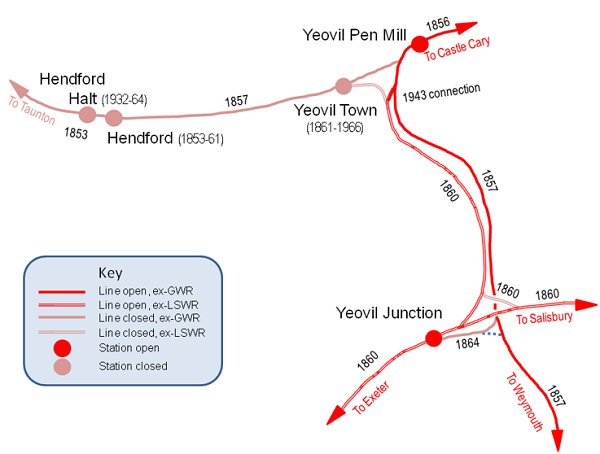
Sketch plan of Yeovil's somewhat complex railway network showing the relative locations of Yeovil Town, Pen Mill and Junction stations, Hendford terminus and Hendford Halt. Click on any station name to open its page.
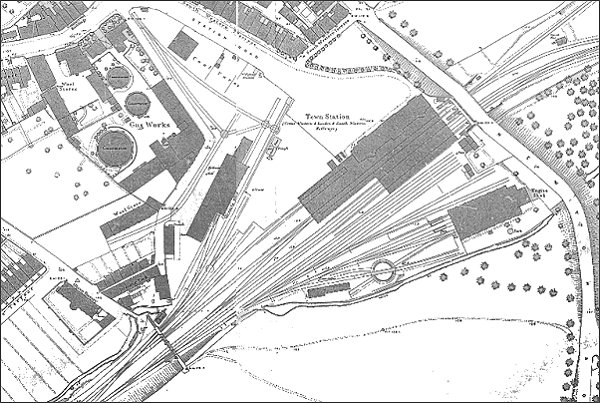
Map based on the 1886 Ordnance Survey showing the complexity of Yeovil Town station, with the main station building right of centre, the engine shed at right with its turntable close by. The coal yard, originally started by William Skinner, runs along Station Road and to its south is the goods yard and goods shed.
gallery
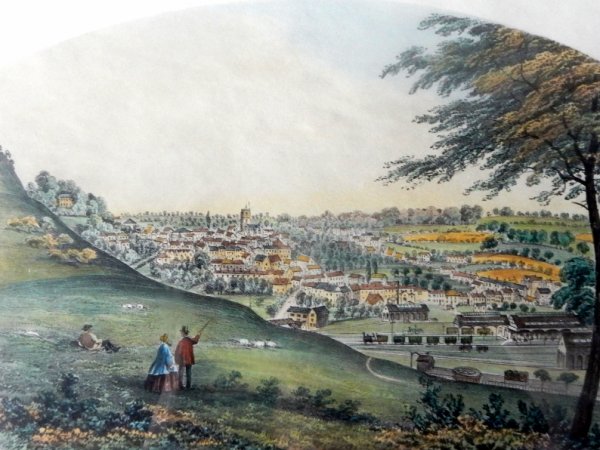
From my
collection
This hand-coloured lithograph, entitled "View of Yeovil from Newton Hill" overlooking the new Yeovil Town Railway Station was made about 1861 (clearly just after the Town Station opened). Drawn by artist and Lithographer Edward Holton Buckler, it was published by Thomas Willy Vincent of Yeovil.
"The town is surrounded on the South East by three remarkable hills - Babylon-hill, Windmill-hill, and Newton-hill. The landscape is also diversified by Newton Copse, the property of George Harbin, Esq., and the beautiful undulating plantations belonging to John Batten, Esq., flanked on the extreme south by some less extensive and elevated grounds, the property of F. Greenham, Esq. From these several points there are prospects so rich in fertility, verdure, and beauty, and smiling prosperity, - such a brightness, a greenness, and a repose, - that the spectator is wrapt in admiration of the view thus spread around and beneath him; and as the hum of distant voices from the busy little town in the valley below reaches his ear, and he looks upon St. John's gray tower, in its hoary age and silent grandeur, rising out of its midst, impressions something akin to adoration force themselves instinctively upon his mind." (Vickery, 1856).
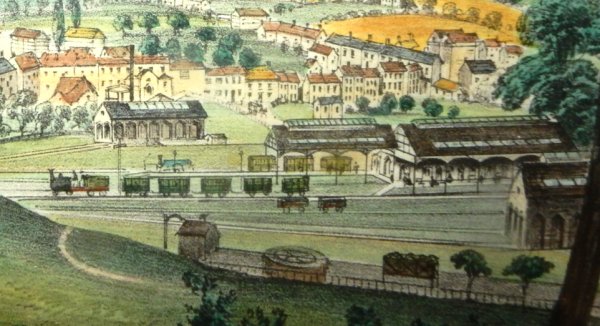
From my
collection
This enlargement of the previous lithograph shows the detail of the train and station much clearer.
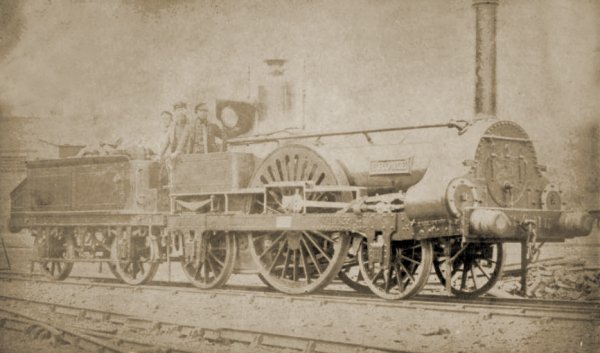
London & South Western Railway locomotive No 114 'Frome' at Yeovil Town Station. Photographed on 8 August 1862.
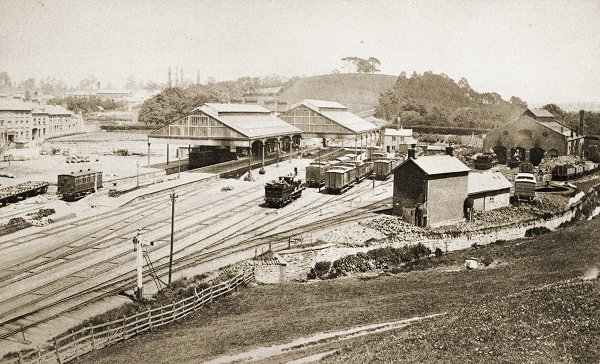
Courtesy of
Roger McElliott
Yeovil Town Station photographed from the lower slopes of Summerhouse Hill during the summer of 1879.
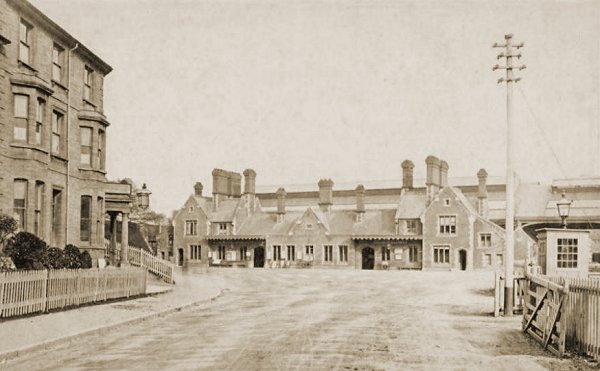
Courtesy of John
Kersting -
This photograph
features in my
book 'Yeovil
From Old
Photographs'
Yeovil Town Station, photographed from Station Road circa 1880.
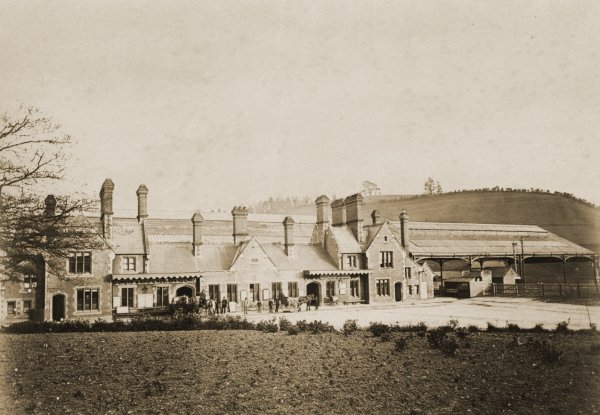
Courtesy of South Somerset Heritage Collection
This photograph of around 1885 by Henry Stiby, shows the fully-covered platforms to the right of the image.
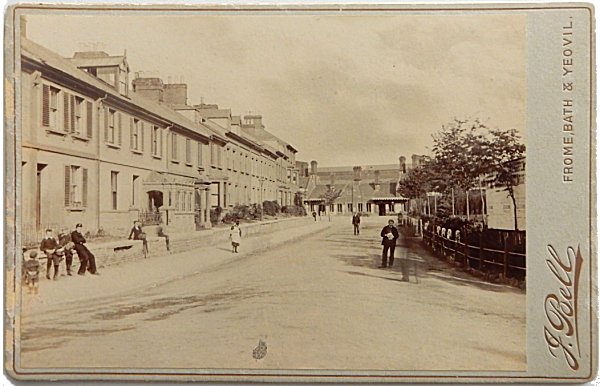
Courtesy of Jack
Sweet -
This photograph
features in my
book 'Yeovil
From Old
Photographs'
Station Road and Yeovil Town Station photographed in 1896 by John Bell. The terrace of buildings at left, still there today, is South Western Terrace built by Levi Ridout.
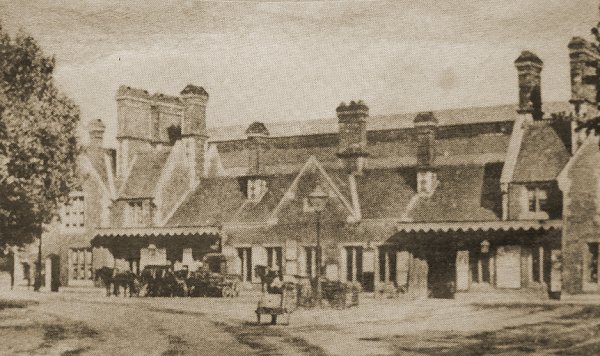
Courtesy of
Colin Haine
Photographed around 1900 when the cabs waiting for passengers in the station forecourt were drawn by horses. From a newspaper clipping.
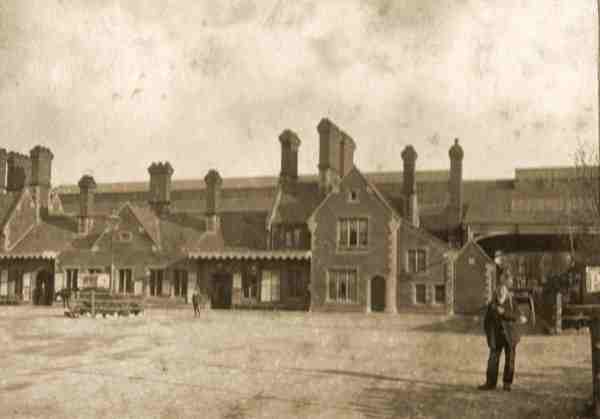
This photograph of the station is by Yeovil photographer William Sherrell and dates to between 1889 and his retirement around 1907.
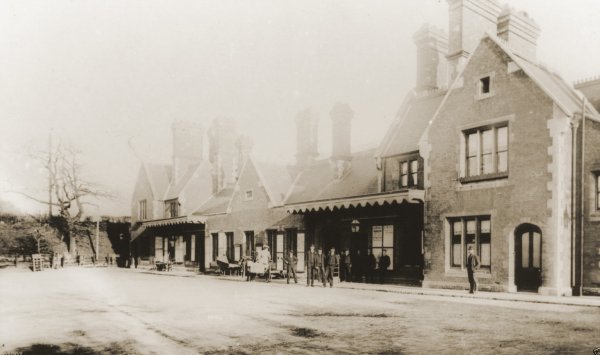
The station photographed around 1905.
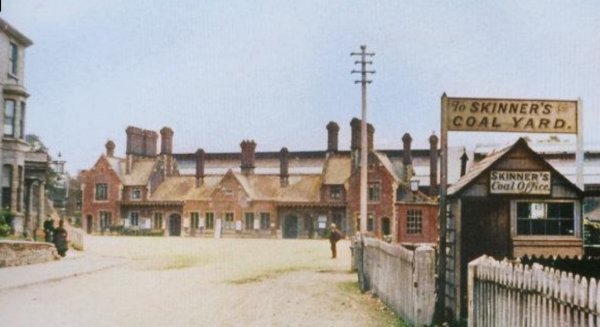
This
image
features in my
book 'Yeovil
- The Postcard
Collection'.
This colourised photograph was taken about 1910 and looks along Station Road. Having worked for many years on the railways, William Skinner obviously appreciated the importance of coal to the new transport system. From working as a railway labourer in 1851 and rising to become a railway inspector in 1861 at the newly opened Yeovil Town Railway Station, seen here at centre, by 1871 he was listed in the census as a coal merchant and cannily located his coal yard, seen here at right, adjacent to the railway goods yard. At left is the Alexandra Hotel, built to accommodate visitors to Yeovil arriving at the station. At the time of this photograph the coal yard was run by William's son, Frederick Skinner.
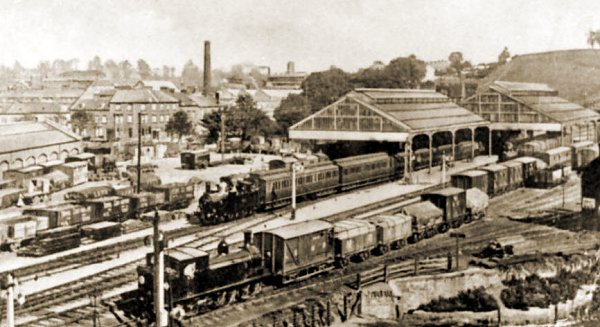
A view of Yeovil Town Station taken from the lower slopes of Summerhouse Hill around 1908. The large glass roofs over the platforms were replaced with smaller ones in 1934 and electric light was installed at the same time. At far left of the picture is the goods shed with the goods yard between the shed and the main station building.
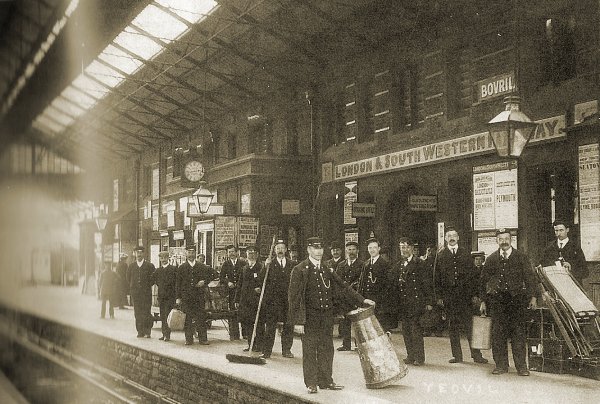
Yeovil Town Station and its staff around (I'm guessing) 1915.
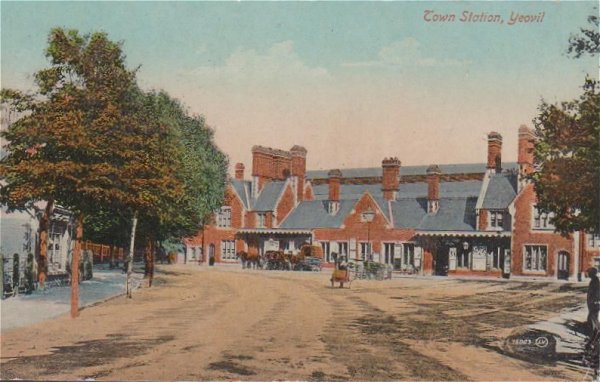
This
photograph
features in my
book "Lost Yeovil"
A hand-coloured postcard of Yeovil Town Station, dating to 1919.
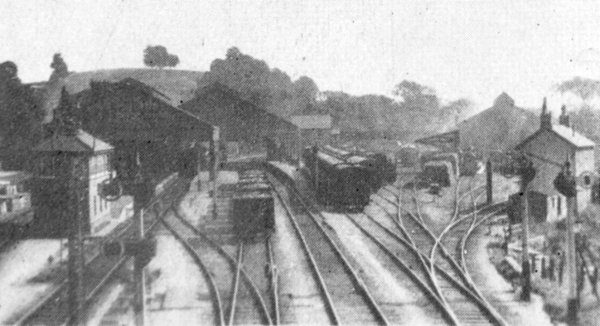
Yeovil Town Station photographed in the 1920s.
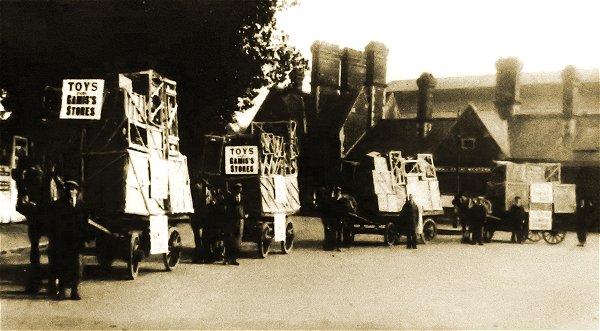
Courtesy of Jack
Sweet
Photographed in 1934 in the forecourt of Yeovil Town railway station, four well-laden horse-drawn carts have just collected boxes of toys for Gamis' stores from the goods yard off-picture to the right.
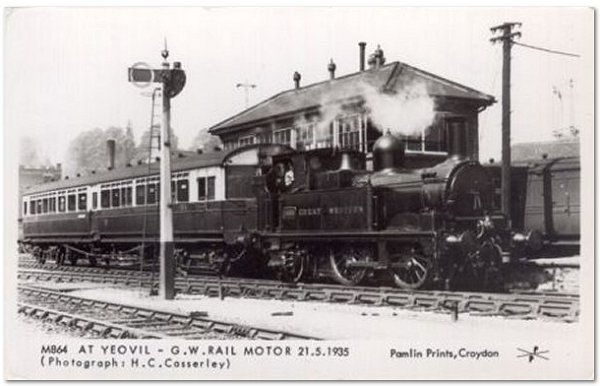
From my
collection
A 1980's postcard featuring a 1935 photograph of a GWR locomotive at Yeovil Town Station. Many thanks to John Penny for pointing out "The signal is a GWR pattern lower-quadrant shunt signal and the signalbox is clearly GWR with those distinctive roof vents." Who'd have thought...
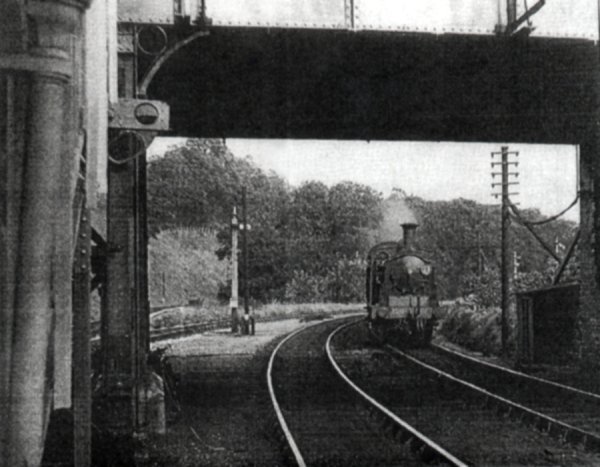
Looking east under Newton Road bridge, when the railway tracks ran under the bridge rather than the access road to the overflow car park. Photographed on 21 September 1945.
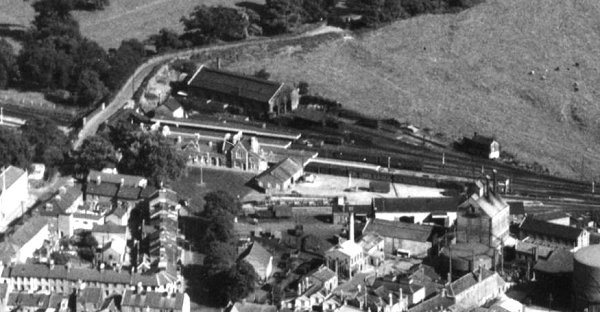
An aerial photograph of Yeovil Town Station dating to 1953. Newton Road is seen running from bottom left to top centre and Station Road is at the bottom, left of centre. The station itself is left of centre with the engine shed beyond it and the goods yard at centre right.
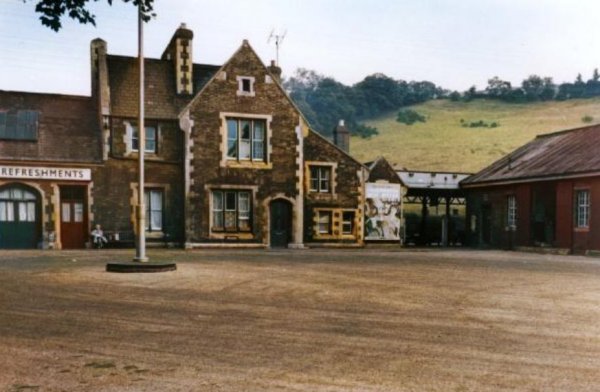
This colourised photograph of the Town Station, is thought to have been taken in the 1950s.
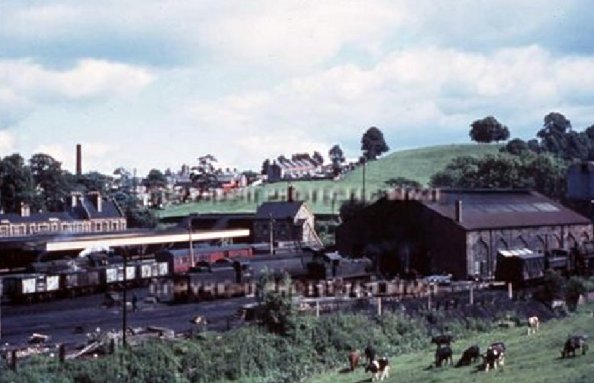
Yeovil Town Station, photographed about 1955 from Summerhouse Hill.
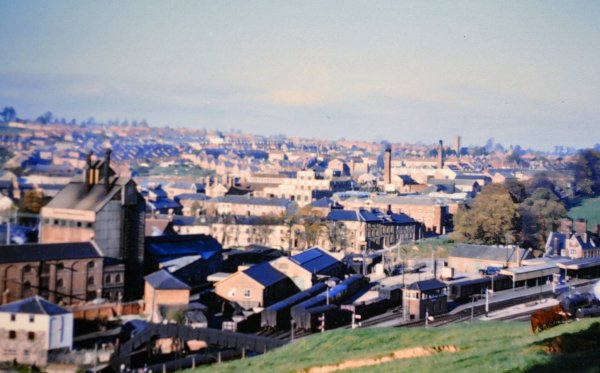
... and seen from halfway up Summerhouse Hill around 1960.
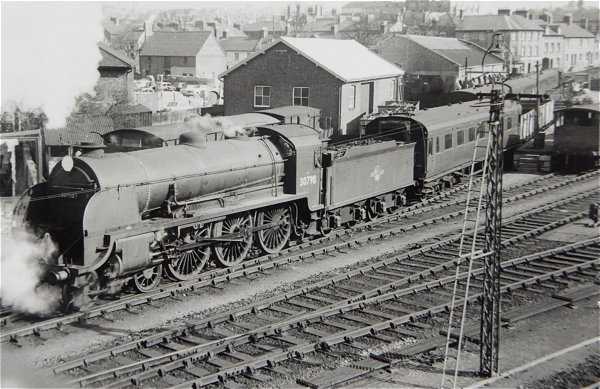
From my
collection
Locomotive 30798 shunting in Yeovil Town Station during the late 1950s. Locomotive No 30798 King Arthur Class 'Sir Hectimere' was withdrawn in June 1962.
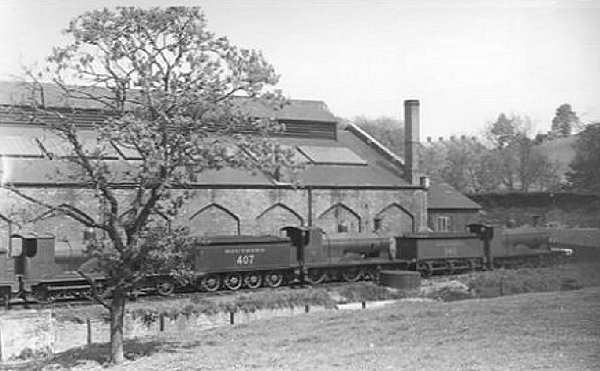
Yeovil Town Station engine shed, circa 1950. The engine shed closed on 12 June 1965.
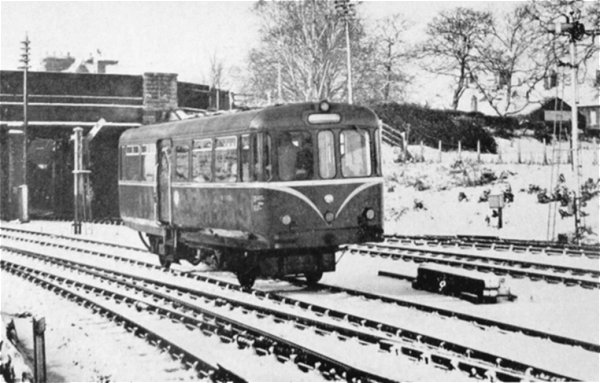
The successor to the pull-and-push trains at Yeovil, an AC Cars Railbus, leaves Yeovil Town Station through the snow as the 11:05 to Yeovil Junction on its first day of regular service, 28 December 1964.
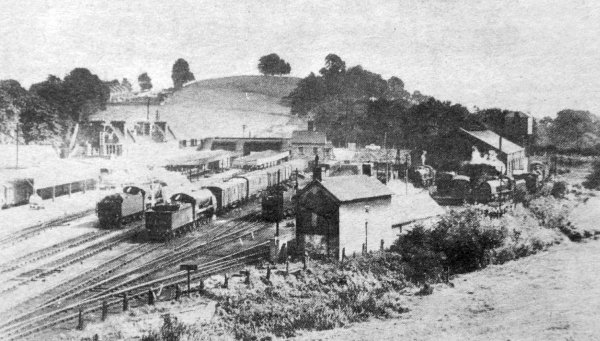
Courtesy of
Colin Haine
Yeovil Town Station in 1961, as published in the Western Gazette.
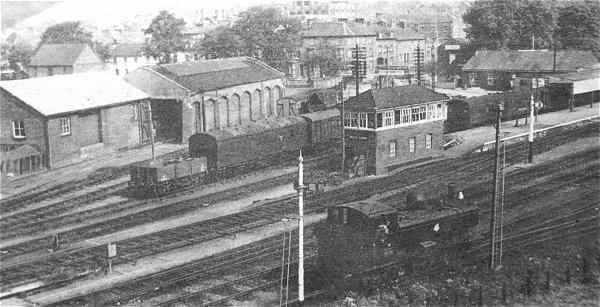
Courtesy of
Colin Haine
Yeovil Town Station in 1961, again, as published in the Western Gazette.
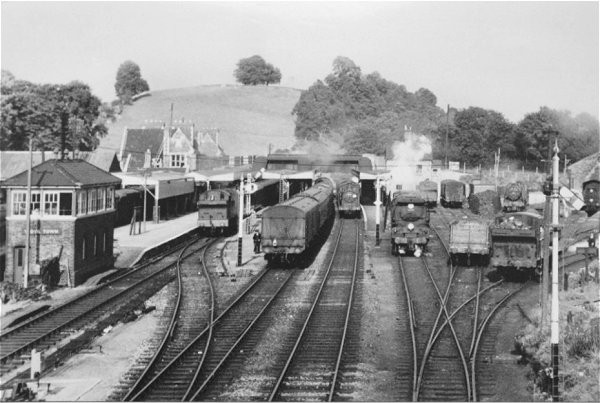
From my
collection
Yeovil Town Station east with trains for Taunton, Salisbury and Yeovil Junction at the platforms. Photographed 8 September 1961.
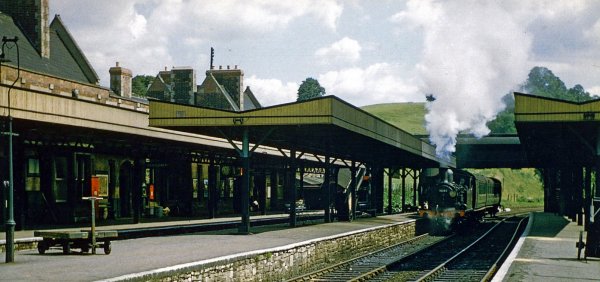
Photo by Nick
Clements,
courtesy of John
Penny
John notes "The loco is an O2. Note that the Westinghouse brake air pump is on the left side of the smokebox. The M7's had them on the other side. The last of this class was withdrawn in 1962 so it could not be after that date. Here, it's captured leaving for Yeovil Junction."
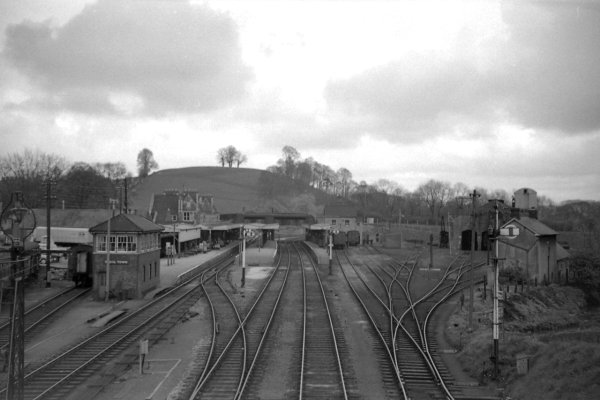
Courtesy of
Richard
Parkhurst
Yeovil Town Station photographed in April 1966.
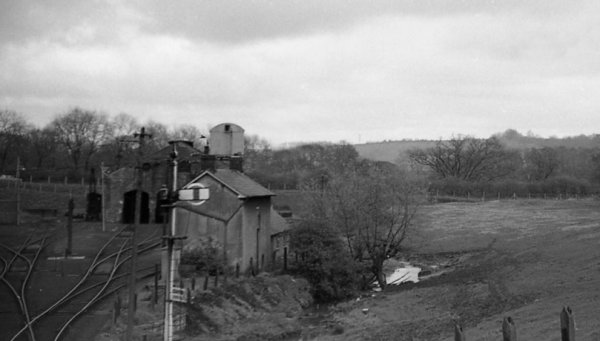
Courtesy of
Richard
Parkhurst
The southern edge of the Yeovil Town Station compound alongside Dodham Brook. Again, photographed in April 1966.
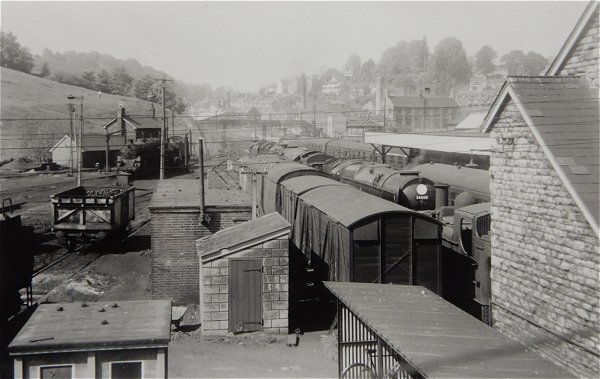
From my
collection
.... and looking west, Yeovil Town station seen from Newton Road bridge Photographed before 1966.
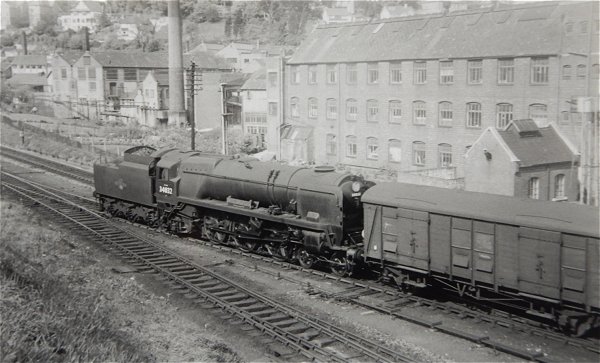
From my
collection
Locomotive 34032 Camelford on the Yeovil Town station sidings behind the Blake & Fox glove factory in Summerhouse Terrace during the 1960s.

The same view as the previous photograph, but this colourised photograph was taken a little further to the west.
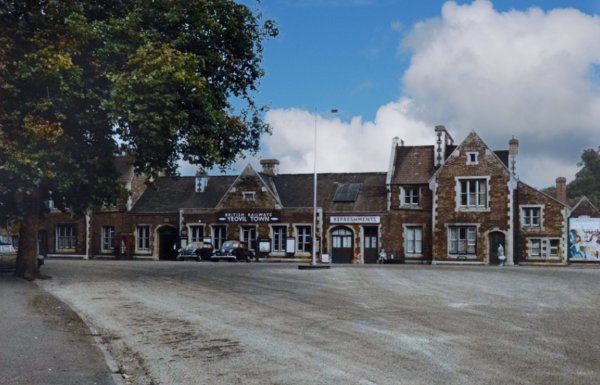
From the Cave
Collection
(colourised),
Courtesy of South Somerset Heritage Collection
Yeovil Town Station, photographed from Station Road circa 1960.

A 1980 postcard featuring a 1964 photograph of the Bournemouth service bus outside Yeovil Town station.
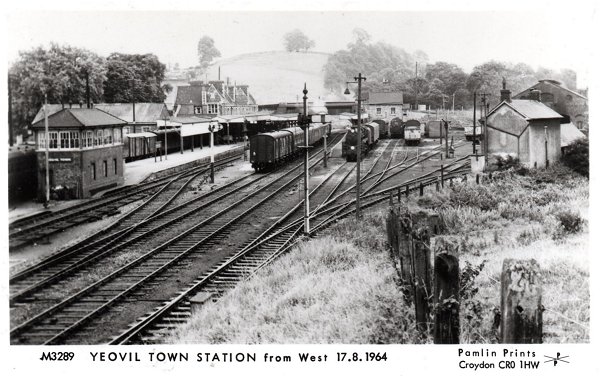
From my
collection
Another 1980s postcard of Yeovil Town Station dated 17 August 1964 - just a couple of years before it closed.
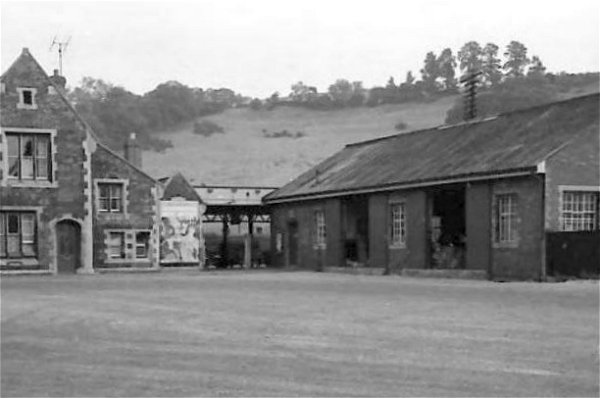
The Town Station parcels shed at right, photographed around 1960.
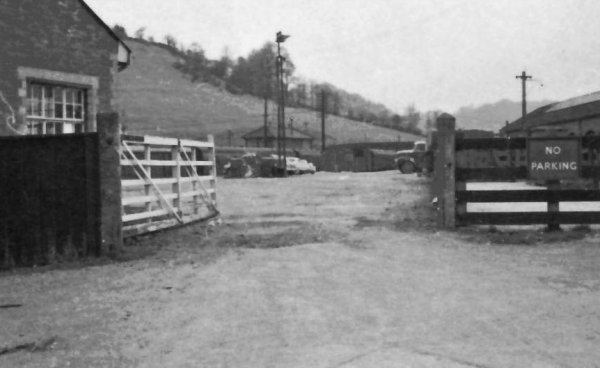
.... and beyond the parcels shed was the goods yard. This area had originally been filled with pens for sheep and cattle but was later used for offloading goods and coal.
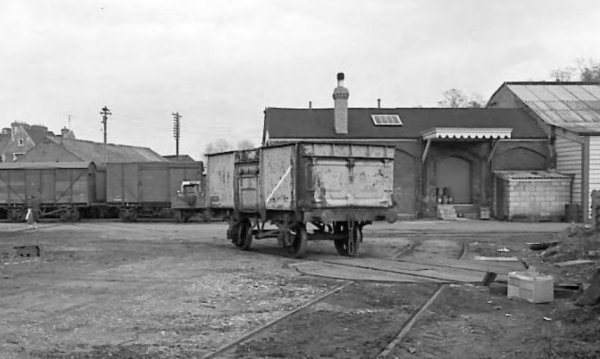
In the goods yard were four manually-operated turntables for goods wagon distribution. This particular turntable was used for moving wagons in and out of the Town Gas Works.
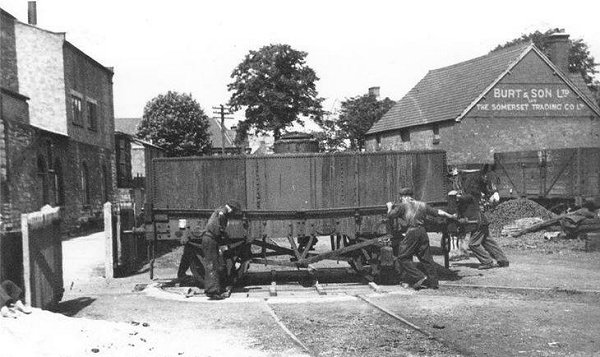
The turntable for Burt's coal yard, previously William Skinner's coal yard, being manually operated.
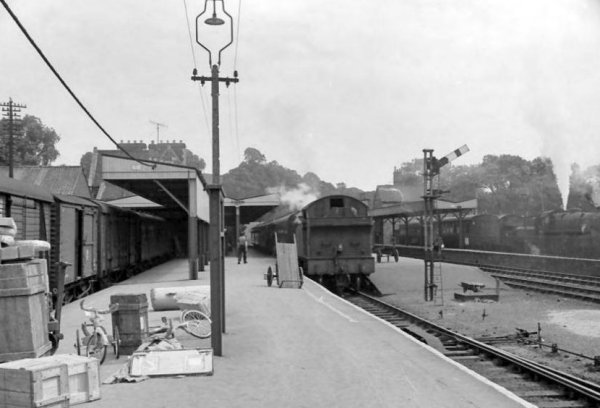
The Yeovil Town Station, platform 1, photographed around 1960.
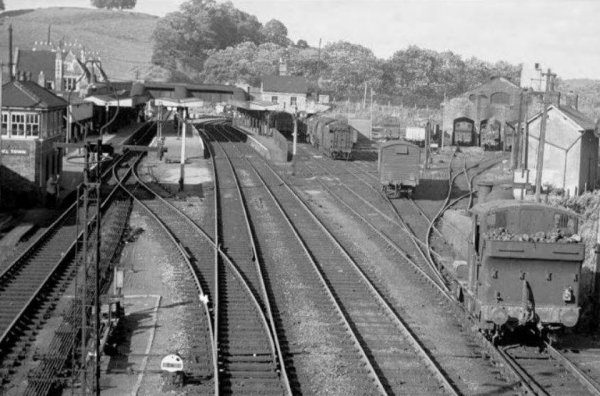
This photograph looks east, with Wyndham Hill at top left. The left platform has the single-track Pen Mill to Taunton line while the double track to and from Yeovil Junction runs between the other two platforms.
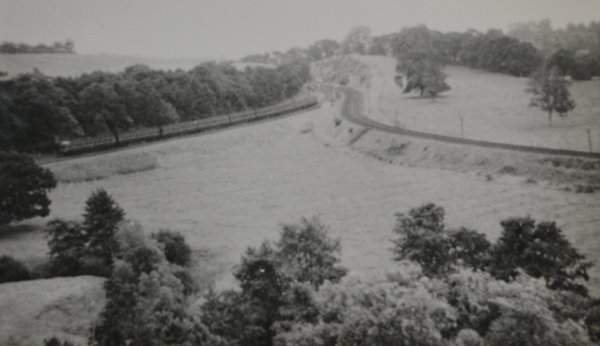
Courtesy of
Vivien and John
Cornelius
A view taken from Wyndham Hill with a diesel multiple unit on the left going into Pen Mill station while on the right are the lines approaching Yeovil Town station. Photographed 1961.
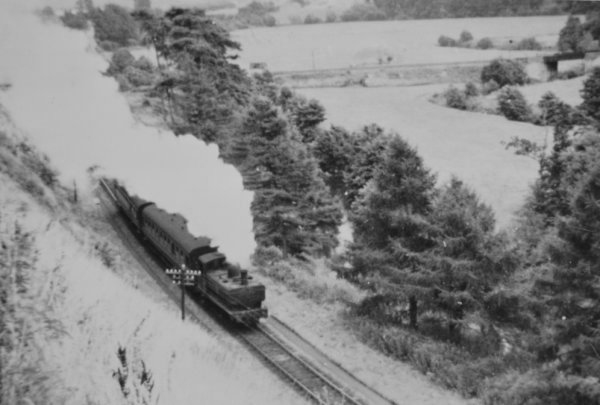
Courtesy of
Vivien and John
Cornelius
The Taunton train between Pen Mill station and Yeovil Town station seen from Wyndham Hill. Photographed 1961.
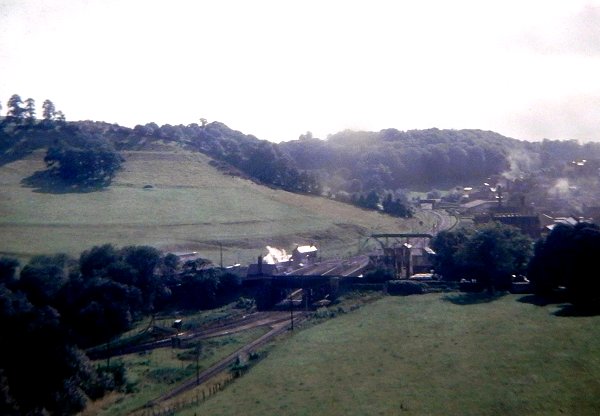
Yeovil Town station seen from Wyndham Hill with Summerhouse Hill at left. Photographed during the 1960s.
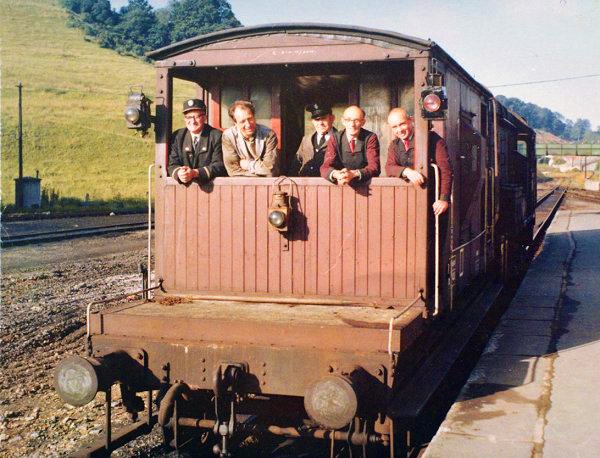
Courtesy of
Vivien and John
Cornelius
A diesel shunter and brake guard's van at Yeovil Town Station. Photographed late 1960s.
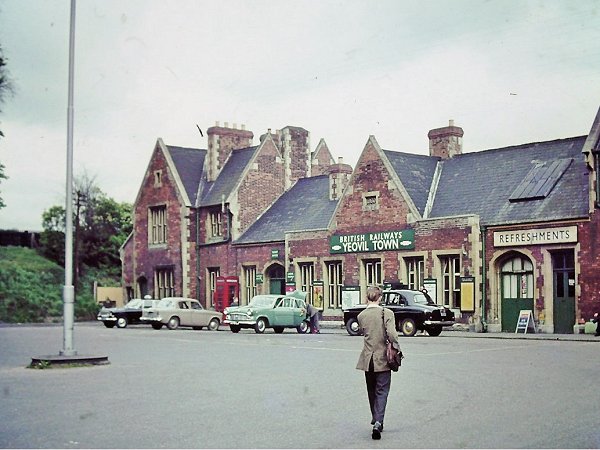
This photograph
features in my
book "A-Z
of Yeovil"
Yeovil Town Station, photographed in the 1960s.
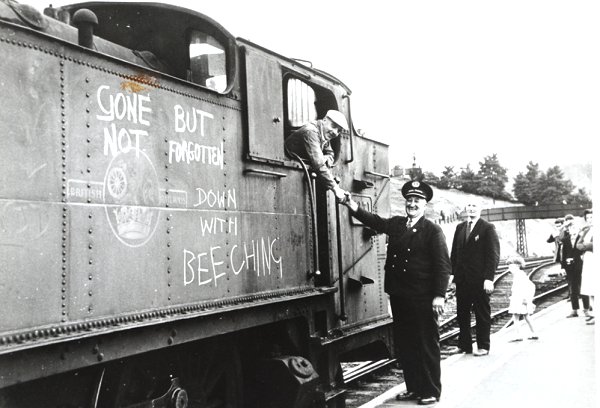
Courtesy of
Vivien and John
Cornelius
The last train to Taunton leaves Yeovil Town Station as the Station Master shakes hands with the driver. (I'm not sure which one added the graffiti). Photographed 1964.
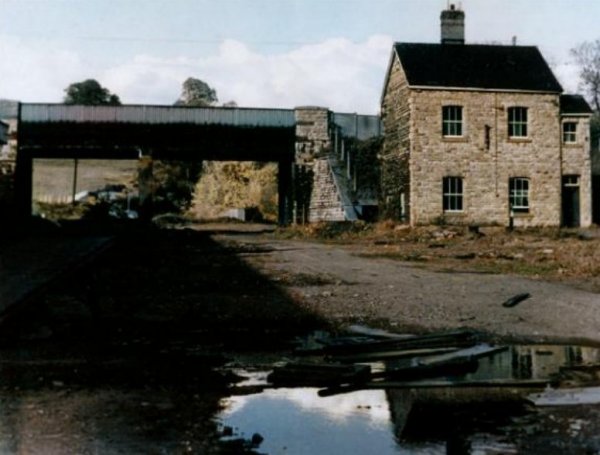
Photographed
(colourised) by
Geoff Bowler,
courtesy of Sue
Bowler
The tracks have gone from the station and the building at right (this was built originally for lodging the guards and footplatemen who worked down from London overnight) will soon be demolished. Photographed in 1969.
Many thanks to Derek Phillips for the following - "The building was described as commodious, containing on the ground floor, a lofty dining hall fitted with a cooking range, has cooking appliances, lockers, lavatories etc., while upstairs, for the use of the men who work the night goods trains between London and Yeovil, are two airy bedrooms containing three beds in each room."
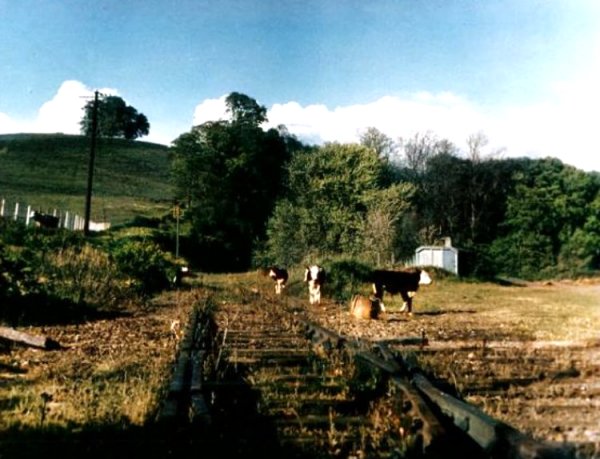
Photographed
(colourised) by
Geoff Bowler,
courtesy of Sue
Bowler
The tracks remained for a short while the other side of the bridge in the previous photograph. Photographed in 1969. This is now the end of the car park extension and the start of the Railway Walk section of Yeovil Country Park.
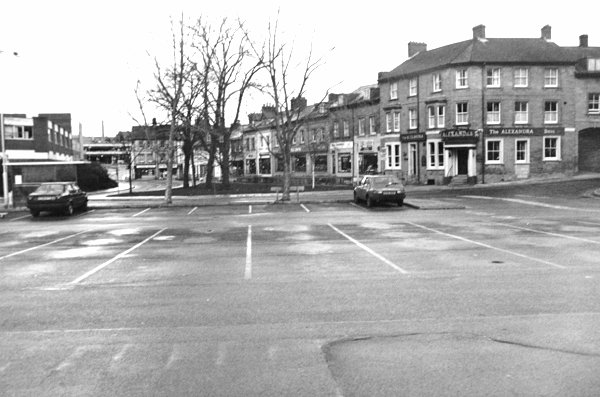
Courtesy of
Chris Rendell
After the removal of the Town Station the site became Old Town Station car park. Photographed in 1985 and facing Old Station Road. Just off-photo to the left was a block of public toilets (shown below) - most convenient - today, of course, if you are up this end of town you have to wait until you get home or go to the cinema or Wetherspoons.
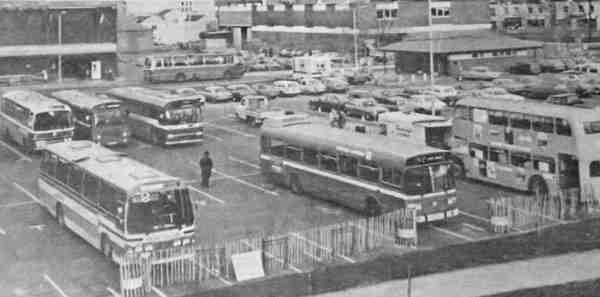
In January 1983, part of the Old Town Station car park became a temporary bus station for some three months while works were undertaken at the bus station at Earle Street.
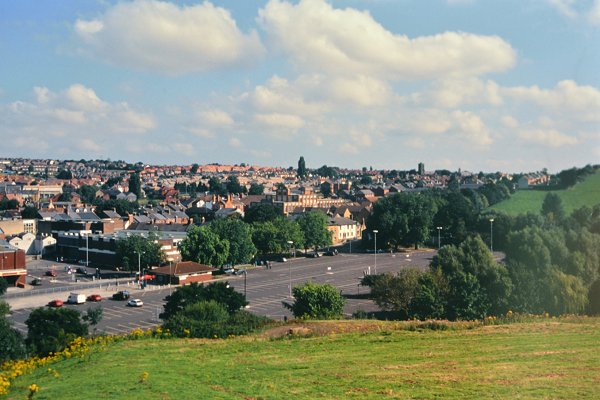
Courtesy of Jack
Sweet
Old Town Station car park photographed from Summerhouse Hill in the 1980s.
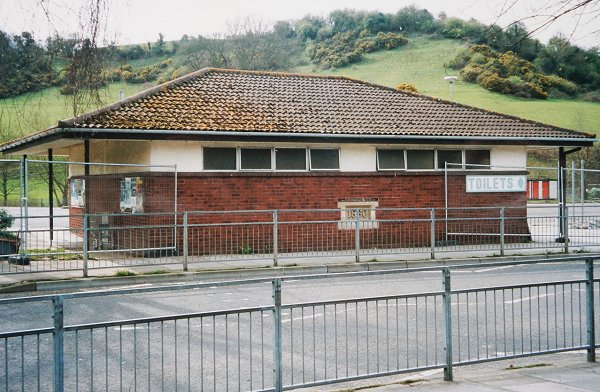
Courtesy of
Vivien and John
Cornelius
The public toilets in Old Town Station car park. Note the foundation stone of the old station embedded in the wall of the toilet block. Photographed just prior to demolition in 2001.
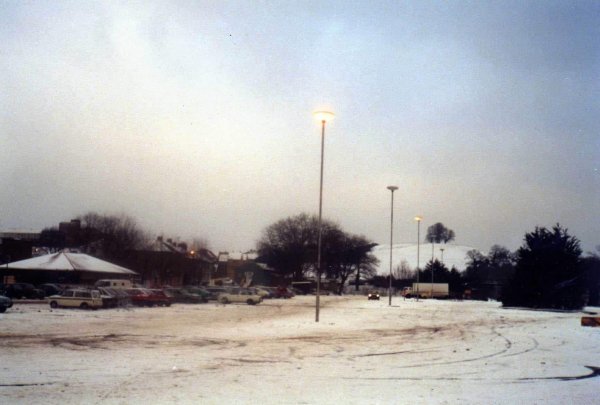
Courtesy of Mark
Rowe
Old Town Station car park, during winter 1982.
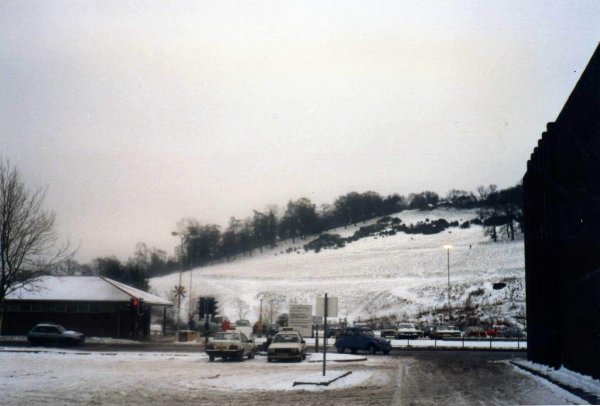
Courtesy of Mark
Rowe
Old Town Station car park and Summerhouse Hill, during winter 1982.
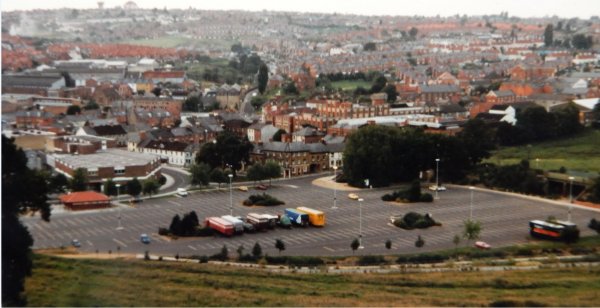
Old Town Station car park, photographed from Summerhouse Hill in the 1980s.
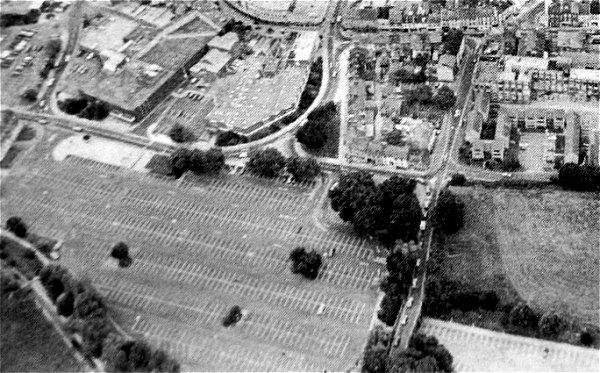
Old Town Station car park photographed in 1992. Running up the right side is Newton Road with the lower slopes of Wyndham Hill at bottom right and the car park extension in the bottom right corner. Key Markets House, recently converted to a Premier Inn, is seen at the top, left of centre, with Station Road (by this time called Old Station Road) running down at top centre.
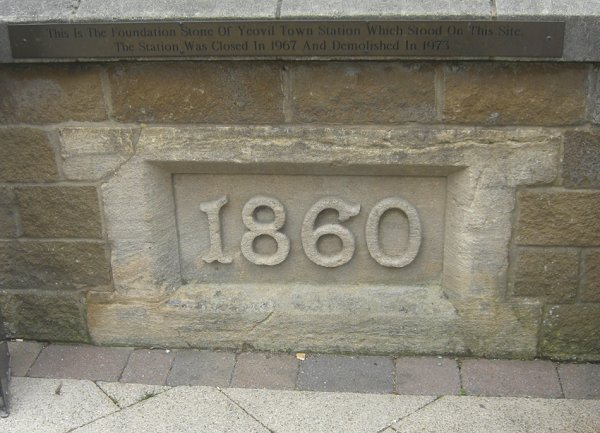
The final remnant of Yeovil Town Station, its foundation stone now built into a raised flower bed close to the entrance of the Yeo Leisure Centre. Photographed in 2014.
A gallery of Yeovil Town Station by David Perry
I am most grateful to David Perry for allowing me to reproduce his photographic study of Yeovil Town Station. David was a student at Yeovil School of Art when it was still in the old building in Kingston and then in the new building in Mudford Road during the period 1962-64.
The following series of David's photographs are all from the 1960s and many thanks to Mike Collins and Derek Philips for their combined knowledge which has enabled many of the photographs to be dated accurately.

Courtesy of
David Perry
A view of the coal yard, photographed around 1962.

Courtesy of
David Perry
At right is Locomotive 31805 by Yeovil Town Station locomotive shed. 31805 was built in 1926 and withdrawn from service on 31 August 1963. At left is 4507 - see next photo.
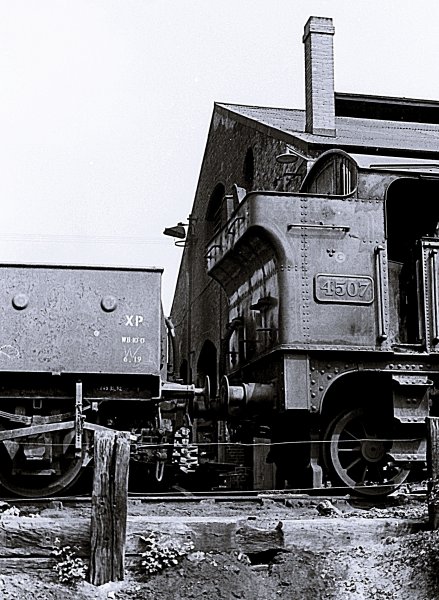
Courtesy of
David Perry
Locomotive 4507 by Yeovil Town Station locomotive shed. 4507 was built in 1907 and withdrawn from service on 31 October 1963.
From Derek Philips - "4507 was reallocated to Yeovil Town from Weymouth in 1960 and withdrawn on 31 October 1963 the photo could have been taken anytime between these dates, incidentally 4507 was the last steam loco built by the GWR at the Wolverhampton Stafford Road Works to remain in service with British Railways when withdrawn in 1963."
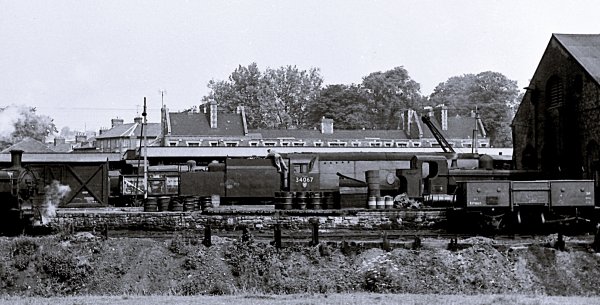
Courtesy of
David Perry
Locomotive 34067 'Tangmere' - introduced in 1945 and withdrawn on 30 November 1963.
From Derek Philips - "Tangmere is still steaming today and has been a regular visitor to Yeovil Junction over the years on steam specials, when this photo was taken she was allocated to Salisbury shed, and in BR days a regular visitor to the Town shed, withdrawn from service in November 1963, the loco was allocated to Salisbury in 1961 so would suggest the photo was taken between 1961/63."
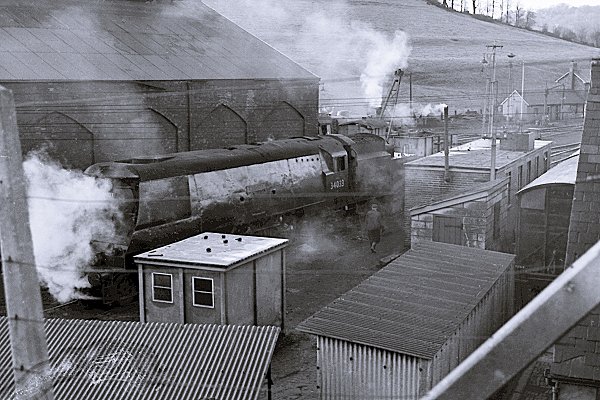
Courtesy of
David Perry
The busy Yeovil Town Station depot photographed from newton Bridge. Locomotive 34033 'Chard' was built in 1946 and withdrawn from service on 31 December 1965.
From Derek Philips - "This is a better photo - the depot when it was alive with steam, smoke and locomotives. A regular visitor to the shed, No.34033 'Chard' was a Plymouth Friary engine from 1951-1964 when allocated to Eastleigh. An engine I worked on as a young fireman. I suggest the photo was taken in 1963."
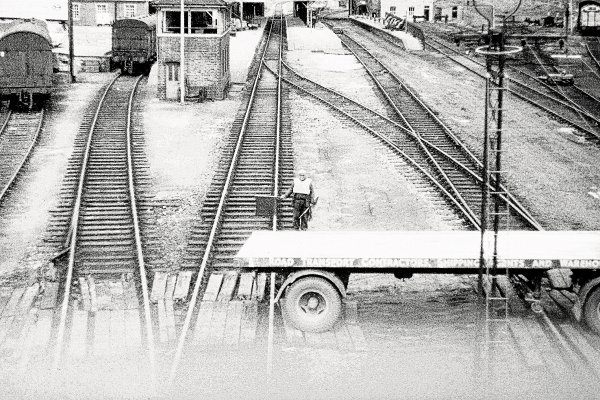
Courtesy of
David Perry
Photographed from Dodham Bridge - a flag-wielding worker marshals a lorry across the tracks. Many thanks to Mike Collins for a reasoned approach to the date - "A couple of vans are present in the yard and parcels can be seen on the platform. Off the top of my head, I believe that the class 121 Pressed Steel single car DMU parked in the shed didn't appear on the Junction shuttles until near the end, so leading me to think that this is likely 1966-67ish."
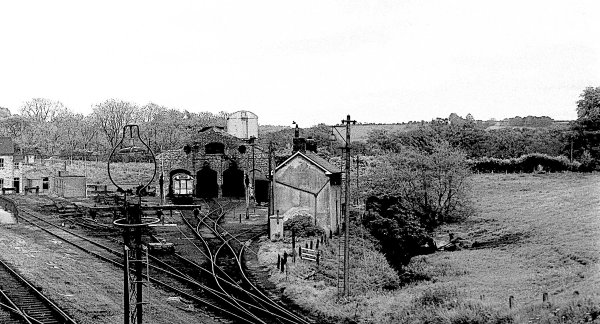
Courtesy of
David Perry
The Town Station engine shed face on, with the lower slopes of Summerhouse Hill to the right. Photographed from Dodham Bridge. Note how the brook meanders along the edge of the field - completely different to today's dead-straight, concrete-lined flood alleviation channel.
There has been quite some debate over the date this photograph was taken. Many thanks to Derek Philips for supplying a definitive answer - " I packed in my job as a railway fireman at Yeovil Town loco shed in July 1964 when I left, everything at the loco and station was in situ, this photo has no signalling, the water columns have been removed and also the track has been removed between the station and Yeovil South Junction, the single unit railcar is probably the one used on the Pen Mill to Yeovil Junction shuttle service. Here are a few dates that may help; 13 June 1965 Yeovil Town shed closed to steam but retained as a stabling point until May 1968; 28 November 1965 last passenger service Yeovil Town-Pen Mill; 2 October 1966 last passenger service Town Station-Yeovil Junction with new Pen Mill-Yeovil Junction service starting next day; 1 March 1967 Yeovil Town-Yeovil South Junction section closed and Yeovil Town signal box closed; August 1967 Yeovil Town-Yeovil South Junction tracks lifted; 5 May 1968 last passenger service Pen Mill-Yeovil Junction; 6 May 1968 Yeovil Pen Mill-Hendford section closed along with the stabling point at Yeovil Town there no longer being a requirement for a branch DMU or a shunting locomotive. My conclusion the date of the photograph is late 1967 or before May 1968."
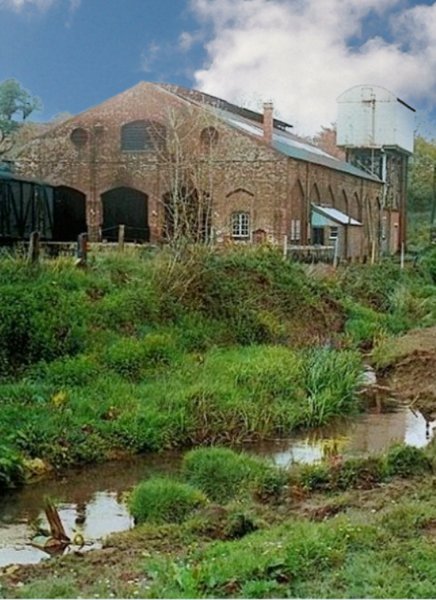
Courtesy of
David Perry
(Colourised)
Even if you're not into railways and sheds this is a cracking evocative photo of the stream before it was converted into today's dead straight concrete-encased flood alleviation channel.
From Derek Philips - "No steam locos in this one although the Eastleigh stores van is there - it can be seen in left foreground and it is not in the other photographs therefore, in my view, taken around the 1967 era."
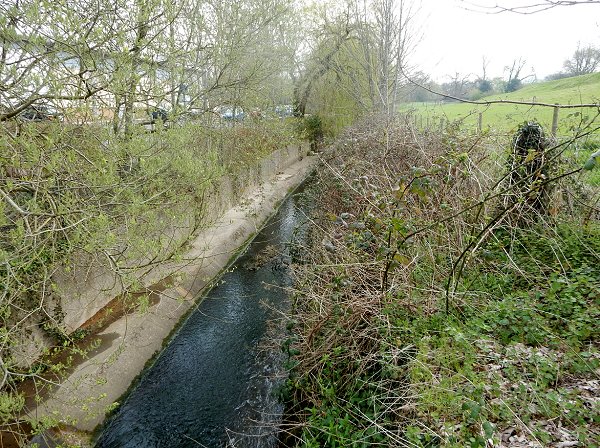
Just for contrast with the previous photograph, this is pretty much the same view in 2016.
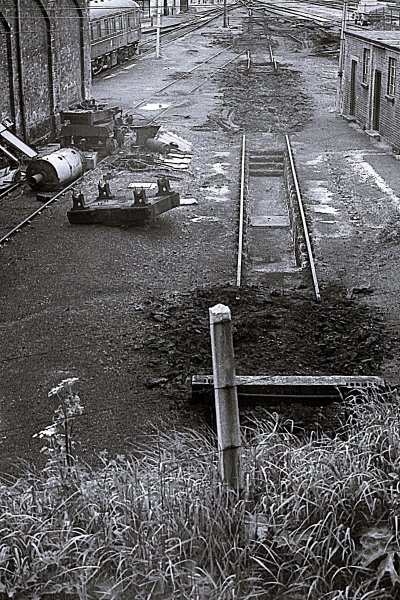
Courtesy of
David Perry
Also photographed from Dodham Bridge. Mike Collins "I would say that this one was taken on the same day as the photos above - late 67 / early 68. Is that the remains of the small steam powered crane that was used to coal the locos laying on the ground by the side of the shed?" to which Derek Philips replied "I agree Mike, the Pen Mill-Junction railcar is there so it can be dated as late 67/early 68, at least pre 5 May 1968 the final day of that service. Unfortunately that is the remains of the old steam crane lying on the ground."
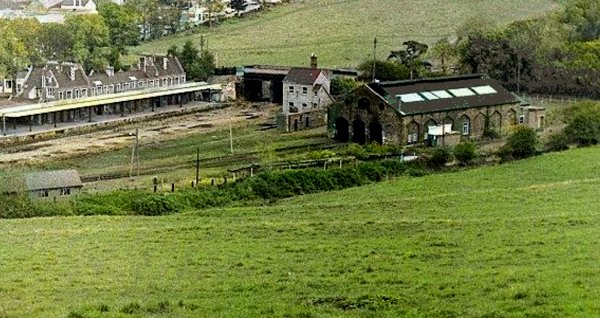
Courtesy of
David Perry
(Colourised)
Yeovil Town Station, seen from the lower slopes of Summerhouse Hill.
From Derek Philips - "Again by process of elimination, looking at the background the Town-South Junction tracks have been removed also platform 3 has gone, the tracks were lifted in August 1967 so the photo was taken after this date.